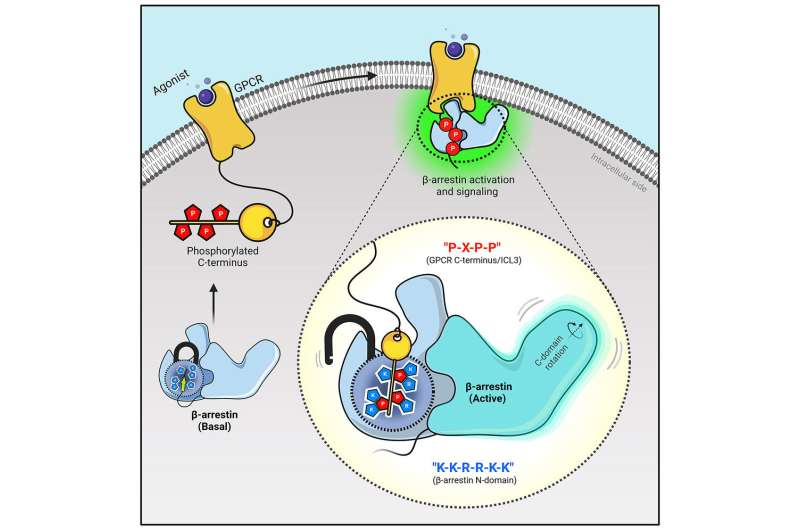This article has been reviewed according to Science X's editorial process and policies. Editors have highlighted the following attributes while ensuring the content's credibility:
fact-checked
peer-reviewed publication
proofread
Researchers visualize communication of G protein-coupled receptors, paving way for new drug discovery

A group of researchers led by Prof. Arun K. Shukla in the Department of Biological Sciences and Bioengineering at the Indian Institute of Technology Kanpur (IIT-K) has unraveled a previously unknown mechanism that regulates an important class of drug targets known as G protein-coupled receptors.
The discovery has important implications for not only understanding the fundamental mechanism of cellular signaling in the human body, but also has the potential to facilitate novel drug discovery for several human disease conditions. The study, published in the May issue of Molecular Cell, was conducted using an innovative technology known as cryogenic-electron microscopy (cryo-EM).
The cells in our bodies are surrounded by a membrane that harbors a special type of protein molecules known as receptors. These receptors are important for the body to sense different chemical and hormones, and respond accordingly by activating specific physiological responses. One particular class of receptors, known as G protein-coupled receptors (GPCRs), is involved in regulating heart function, blood pressure, mental disorders, and our behavior. Several drugs such as those used for depression, heart failure, cancer, and hypertension work by modulating these receptor proteins.
The function of GPCRs is regulated by another family of proteins in the body known as arrestins, which bind to GPCRs and control their function and physiological responses. However, a complete understanding of GPCR-arrestin interaction has been mostly elusive so far. The researchers have now visualized the cross-talk of GPCRs and arrestins in great detail using the new technology, cryogenic-electron microscopy (cryo-EM). This has allowed the team to discover a novel mechanism that is responsible for regulating the function of GPCRs in the body.
Prof Shukla says, "This study has opened up novel directions for improving the currently existing medicines by lowering their side effects, and also provides an opportunity for discovering new medicine for several human disease conditions. For example, the chemokine receptor that is one of the receptors investigated in this study has important roles in breast cancer progression, while the complement receptors also investigated here are important targets for treating inflammatory disorders such as rheumatoid arthritis."
The researchers are now working in the direction of novel drug discovery in collaboration with several international laboratories, including studies in animal models.
This study is led by Prof. Arun K. Shukla and is co-authored by Ph.D. students Mr. Jagannath Maharana, Ms. Parishmita Sarma and Ms. Shirsha Saha, post-doctoral fellows Dr. Ramanuj Banerjee and Dr. Manish Yadav, and project fellows Mr. Sayantan Saha and Mr. Vinay Singh. The study also includes Dr. Mohamed Chami from the University of Basel in Switzerland as a collaborator.
More information: Jagannath Maharana et al, Structural snapshots uncover a key phosphorylation motif in GPCRs driving β-arrestin activation, Molecular Cell (2023). DOI: 10.1016/j.molcel.2023.04.025
Journal information: Molecular Cell
Provided by Indian Institute of Technology Kanpur


















